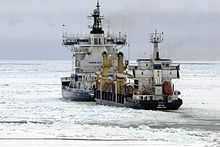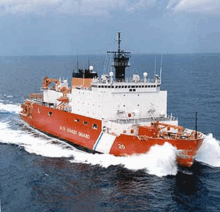I am a South African living on the shores of a huge inland sea in Sweden. After 13 years I still find snow and ice absolutely and utterly fascinating and enchanting. I love watching the sea freeze over and people going long-distance skating on it. But most of all I love the icebreakers that free a path for the huge cement tankers going between cities.
The small ones that go past my window raise up out of the water and smash down on the ice, also rolling from side to side to clear a path. They are very noisy and the constant motion makes them not very pleasant to ride on if you suffer seasickness. The sound of them smashing through the ice is very distinctive.
The larger ones in the Baltic sea use jets of hot water to work their way through the ice.
I have a bit of info from Wikipedia and then below that I have five videos
From Wikipedia:
For a ship to be considered an icebreaker, it requires three traits most normal ships lack: a strengthened hull, an ice-clearing shape, and the power to push through sea ice.
Icebreakers clear paths by pushing straight into ice pockets. The bending strength of sea ice is so low that usually the ice breaks without noticeable change in the vessel’s trim. In cases of very thick ice, an icebreaker can drive its bow onto the ice to break it under the weight of the ship. Because a buildup of broken ice in front of a ship can slow it down much more than the breaking of the ice itself, icebreakers have a specially designed hull to direct the broken ice around or under the vessel. The external components of the ship’s propulsion system (propellers, propeller shafts, etc.) are at even greater risk of damage than the vessel’s hull, so the ability of an icebreaker to propel itself onto the ice, break it, and clear the debris from its path successfully is essential for its safety.
Function of icebreakers
Icebreakers are needed to keep trade routes open where there are either seasonal or permanent ice conditions as well as escort merchant ships in ice-infested waters. Icebreakers are expensive to build and very expensive to run, whether the icebreaker is powered by diesel engines, gas turbines or nuclear energy. They are uncomfortable to travel in on the open sea: almost all of them have thick, rounded keels, and with no protuberances for stability, they can roll even in light seas. They are also uncomfortable to travel in when breaking through continuous thick ice due to constant motion, noise, and vibration.
Modern icebreakers may have one or more of the following special features designed to prevent the ship from getting stuck in ice or help it to break free if it does so: propellers in both bow and stern; azimuth thrusters; pumps to move water ballast from side to side; and holes on the hull below the waterline to eject air bubbles. Many icebreakers also carry aircraft (formerlyseaplanes but now helicopters) to assist in reconnaissance and liaison.
Design and construction
Ice resistance and hull form

It is often incorrectly believed that an icebreaker drives its bow onto the ice and breaks it under the weight of the ship. While this may hold true in very thick ice, in reality the bending strength of sea ice is so low that the ice fails due to vertical loading before any noticeable change in the ship’s trim is detected.
When an icebreaker is designed, one of the main goals is to minimize the ice resistance of the vessel. Although a number of different analytical, semi-empirical and empirical models have been developed over the years to estimate the forces from the interaction of the ship’s hull and the surrounding ice, these forces are generally divided into breaking, submergence and frictional forces. The breaking forces are caused by crushing and bending of the ice as well as turning of the broken ice floes against the ship’s hull. Once broken, the ice floes are pushed down along the hull, resulting in submergence and frictional forces. In unbroken level ice, the breaking component is generally dominating, but in brash ice and ice ridges the submergence and frictional components become more important. The average value of the longitudinal components of these instantaneous forces is called the ship’s ice resistance.[10] In addition to this, the hydrodynamic (open water) resistance of the vessel must also be taken into account.
Naval architects who design icebreakers use the so-called h-v-curve to determine the icebreaking capability of the vessel. It shows the speed (v) that the ship is able to achieve as a function of ice thickness (h). This is done by solving the velocity at which the thrust from the propellers equals to the total resistance of the vessel.[10] An alternative means to determine the icebreaking capability of a vessel in different ice conditions is to perform model tests in an ice tank. Regardless of the method, the actual performance of new icebreakers is verified in ice trials once the ship has been built.
In order to minimize the icebreaking forces, the hull lines of an icebreaker are designed so that the flare at the waterline is as small as possible. As a result, icebreaking ships are characterized by a sloping or rounded stem as well as sloping sides.[10] However, a spoon-shaped bow results in poor seakeeping characteristics and makes the foreship susceptible to slamming. Some icebreakers have a hull that is wider in the bow than in the stern. These so-called “reamers” increase the width of the ice channel and thus reduce frictional resistance in the aftship as well as improve the ship’s maneuverability in ice. In addition to low friction paint, some icebreakers utilize an explosion-welded abrasion-resistant stainless steel ice belt that further reduces friction and protects the ship’s hull from corrosion.
Icebreakers are constructed with a double hull and watertight compartments in case of a breach. The ship’s hull is thicker than normal, especially at the bow, stern, and waterline, using special steel that has optimum performance at low temperatures. The thicker steel at the waterline typically extends about 1 m above and below the waterline and is reinforced with extra internal ribbing, sometimes twice the ribbing of a normal ship. The hull has no appendages likely to be damaged by the ice, and the rudder and propeller are protected by the shape of the hull. The propeller blades are strengthened, and the vessel has the ability to inspect and replace blades while at sea.[11]

The optimal shape for moving through ice makes icebreakers uncomfortable in open water and gives them poor fuel efficiency. In open-water travel, icebreakers tend to roll side to side to the discomfort of the crew. Some new icebreakers, such as theUSCGC Healy, make use of anti-roll tanks, incompletely filled ballast tanks which span the beam of the vessel. Ballast water in these tanks is allowed to move side to side, or slosh, as a free surface. Retarding baffles inside the anti-roll tank slow the side-to-side flow of water. By varying the water level inside the anti-roll tank, the natural frequency of the slosh is used to counteract the rolling of the vessel. Anti-roll tanks by their nature decrease a ship’s stability and must always be used with caution. Use of computer-controlled valves allow for better control of these anti-roll tanks.
If built according to the rules set by a classification society such as the American Bureau of Shipping, icebreakers may be assigned an ice class based on the level of ice strengthening in the ship’s hull. It is usually determined by the maximum ice thickness where the ship is expected to operate and other requirements such as possible limitations on ramming. In the 2000s, International Association of Classification Societies (IACS) has proposed adopting an unified system known as the Polar class to replace classification society specific ice class notations. It should be noted that the ice class is only an indication of the level of ice strengthening, not the actual icebreaking capability of an icebreaker.


